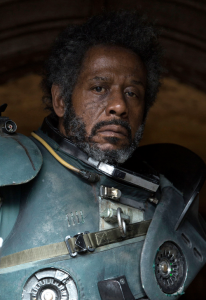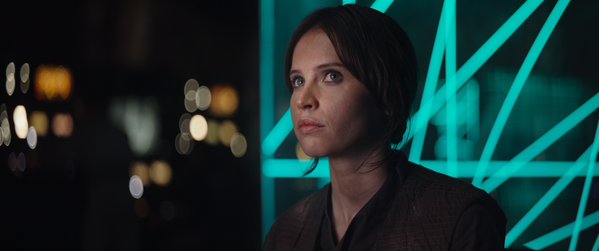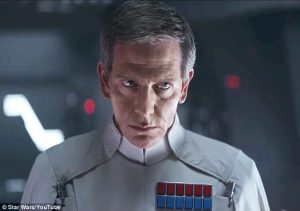Star Wars has always been about the struggle of good against evil. The original trilogy explored how self-sacrifice led to salvation and the prequels how “war through force” leads to destruction. The Force Awakens added a new exploration of evil where, in contrast to Darth Vader who sought power and control to save those he loved, Kylo Ren seeks it only to make a name for himself and carve out “his own place in the universe.”
Rogue One adds to Star Wars’ reflection on this struggle.
Warning: This is full of spoilers!
Petty Ambition
Orson Krennic is responsible for building the Death Star. He is a high-ranking officer but not the highest ranking officer. Between him and the Emperor stands both Vader and Grand Moff Tarkin. At every turn, Tarkin attempts to undermine Krennic, criticizing his work, his control of the situation, and his ability to complete the project. Even when the Death Star proves successful, Tarkin moves to take control of it from Krennic.
Krennic fights with Tarkin, not because of ideological differences but because Tarkin stand in his way. Krennic wants to be recognized and promoted. He wants more stripes on his stark, white uniform. When the first test of the Death Star destroys a city on Jedha and initiates a shock wave around the planet, Kreenic declares it to be “beautiful.” He does not seem to mean that the explosion is beautiful but rather that the success of his weapon—especially since it shows up Tarkin—means that his future career looks “beautiful.” He will be rewarded. He will sit at table with the Emperor. He will outrank Tarkin.
The smallness of his desires is almost comical except that he is willing to kidnap, kill, and commit planetary genocide to fulfill them. He has no grand vision of an Empire. He has no goal or ideal that he is pursuing. He is not Milton’s prideful Lucifer who finds it “better to rule in Hell than to serve in Heaven.” Instead, he is like an assistant manager who threatens the manager to get a promotion.
Thus, it is not too surprising that Vader—who does have a grand vision for the Empire—is the one who cautions Kreenic, saying (after force choking him), “Be careful not to choke on your aspirations, Director.”
Questionable Means
 In Rogue One, the Rebellion is just beginning. It is still trying to coalesce as a group that can take on the Empire. In Star Wars, the Rebellion has always been good. Here, though, in these early stages, there is some ambiguity. They have a good cause but they have questionable means. As one of trailers for the movie asked, “If you continue to fight, what will you become?”
In Rogue One, the Rebellion is just beginning. It is still trying to coalesce as a group that can take on the Empire. In Star Wars, the Rebellion has always been good. Here, though, in these early stages, there is some ambiguity. They have a good cause but they have questionable means. As one of trailers for the movie asked, “If you continue to fight, what will you become?”
When Cassian Andor first appears, he kills a fellow rebel to keep him from being kidnapped by the Empire and betraying the Rebellion. When we meet Saw Gerrera, he is a half-crazed, quasi-terrorist. He even has a breathing apparatus making him sound like Darth Vader. The Rebellion has a tenuous relationship with him because, while he fights against the Empire, he does so using extremely violent means.
For so long, Luke and Leah defined the Rebellion, so we never questioned its goodness. With Rogue One, we do. Their willingness to kill, assassinate, and set road-side bombs should give us pause. It should make us remember that the ends do not justify the means, that we should not do evil so good might come.
Sacrificial Love
Attempting to justify his own approach and convince Jen Erso to join the Rebellion, Saw Gerrera asks her if she could bear to see the Imperial flags waiving over every city throughout the galaxy. Jen replies, “It’s not a problem, if you don’t look up.” While it sounds like an attempt to stay out of it all, I think it is Jen’s proposal for acting differently, one that challenges Saw’s and Cassian’s willingness to employ questionable means, an approach she likens to that of a Stormtrooper.
Jen directs them away from their “up” in the air ideals, ideals that can justify killing, and toward those people “down” on the ground. Thus, Jen reaches out to Chirrut Îmwe, the blind man who is a devotee of the Force, while Cassian tells her they are not to make friends. As Saw Gerrer’s men launch a surprise attack on a platoon of Stormtroopers, Jen runs out into combat to save a little girl. When they are stealing the plans to the Death Star, K-2SO is left behind to guard the doors. Jen is the only one to give him a gun to defend himself.
In each moment, Jen is looking to help those around her. In the movie’s climax, she realizes that, if she is truly going to help people by stopping the Death Star, she will die. It is this vision—helping others, even to the point of laying down one’s life—that gets played out by every member of Rogue One. K-2SO is blasted apart fighting off Stormtroopers to give Cassian and Jen time to get the Death Star plans. Cassia goes down fighting off Krennic to protect Jen. Chirrut Îmwe dies after turning on the master link so the plans can be transmitted. Baze Malbus is killed while protecting Chirrut Îmwe. Bodhi Rook dies in an explosion after sending the plans. The Rebellion has moved from some idealistic cause willing to kill others to a rebellion against evil that is fought through acts of sacrificial love. Krennic’s petty ambitions look that much smaller when so many people are willing to lay down their lives to save friends, neighbors, and strangers.
In seeking to explore what overcomes evil, from its grand totalitarian instantiation to its small, narcissistic manifestations, Star Wars finds the ultimate force in the universe to be sacrificial love. It is a story that Christians should know well.






